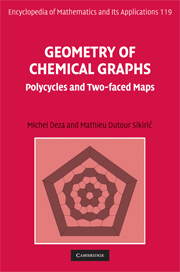Book contents
- Frontmatter
- Contents
- Preface
- 1 Introduction
- 2 Two-faced maps
- 3 Fullerenes as tilings of surfaces
- 4 Polycycles
- 5 Polycycles with given boundary
- 6 Symmetries of polycycles
- 7 Elementary polycycles
- 8 Applications of elementary decompositions to (r, q)-polycycles
- 9 Strictly face-regular spheres and tori
- 10 Parabolic weakly face-regular spheres
- 11 General properties of 3-valent face-regular maps
- 12 Spheres and tori that are aRi
- 13 Frank-Kasper spheres and tori
- 14 Spheres and tori that are bR1
- 15 Spheres and tori that are bR2
- 16 Spheres and tori that are bR3
- 17 Spheres and tori that are bR4
- 18 Spheres and tori that are bRj for j ≥ 5
- 19 Icosahedral fulleroids
- References
- Index
7 - Elementary polycycles
Published online by Cambridge University Press: 06 July 2010
- Frontmatter
- Contents
- Preface
- 1 Introduction
- 2 Two-faced maps
- 3 Fullerenes as tilings of surfaces
- 4 Polycycles
- 5 Polycycles with given boundary
- 6 Symmetries of polycycles
- 7 Elementary polycycles
- 8 Applications of elementary decompositions to (r, q)-polycycles
- 9 Strictly face-regular spheres and tori
- 10 Parabolic weakly face-regular spheres
- 11 General properties of 3-valent face-regular maps
- 12 Spheres and tori that are aRi
- 13 Frank-Kasper spheres and tori
- 14 Spheres and tori that are bR1
- 15 Spheres and tori that are bR2
- 16 Spheres and tori that are bR3
- 17 Spheres and tori that are bR4
- 18 Spheres and tori that are bRj for j ≥ 5
- 19 Icosahedral fulleroids
- References
- Index
Summary
We have seen in Section 4.5 a full classification of (3, 3)gen-, (3, 4)gen-, and (4, 3)gen polycycles. We have also seen that, for all other (r, q), there is a continuum of (r, q)-polycycles. The purpose of this chapter is to introduce a decomposition of polycycles into elementary components in an analogous way to decompose the molecules into atoms. This method will prove to be very effective but only in the elliptic case, since, for all other cases, we will show that there is a continuum of such elementary components (see Theorem 7.2.1). The first occurrence of the method is in, followed by and.
Decomposition of polycycles
Given an integer q > 3 and a set R ⊂ − {1} (so, 2-gons will be permitted in this chapter), a (R, q)gen-polycycle is a non-empty 2-connected map on a surface S with faces partitioned in two non-empty sets F1 and F2, so it holds that:
(i) all elements of F1 (called proper faces) are combinatorial i-gons with i ∈ R;
(ii) all elements of F2 (called holes, the exterior face(s) are amongst them) are pairwisely disjoint, i.e. have no common vertices;
(iii) all vertices have degree within {2, …, q} and all interior (i.e. not on the boundary of a hole) vertices are q-valent.
The map can be finite or infinite and some holes can be i-gons with i ∈ R. If R = {r}, then the above definition corresponds to (r, q)gen-polycycles.
- Type
- Chapter
- Information
- Geometry of Chemical GraphsPolycycles and Two-faced Maps, pp. 73 - 106Publisher: Cambridge University PressPrint publication year: 2008

